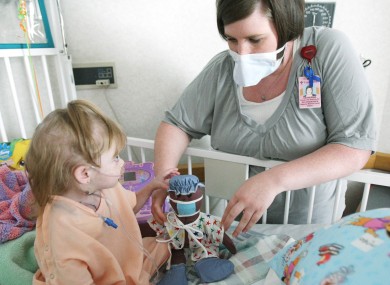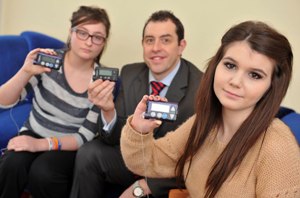Obama’s cousin Henry Healy is confident the president will return to Ireland


Barack Obama’s Irish relative, Henry Healy, has said he is confident of another Presidential visit to Ireland.
It is being reported that behind-the-scenes discussions are underway to arrange for Mr Obama to attend one of a number of events being held this year to mark the 50th anniversary of JFK’s Irish tour.
Members of the Kennedy clan are expected here to oversee the official opening of a new JFK visitor centre during the summer, around the same time President Obama is due in Co. Fermanagh for the G8 summit.
His cousin eight-times removed, Henry Healy, who attended yesterday’s inauguration and ball said he knows the president and Mrs Obama would like to come back.
Henry said: “I think the reason the connection has stayed so strong between us is because the president really felt the warmth from the people of Moneygall and in Ireland on his visit.
“The White House staff has said it to us on many occasions that it is one of his most favourite trips abroad.”
High quality global journalism requires investment. Please share this article with others using the link below, do not cut & paste the article. See our Ts&Cs and Copyright Policy for more detail.
High quality global journalism requires investment. Please share this article with others using the link below, do not cut & paste the article. See our Ts&Cs and Copyright Policy for more detail.
Ryanair to sell 40% share to Flybe, a UK-based regional airline after making concessions on Aer Lingus


Ryanair is offering to sell around 40 per cent of Aer Lingus’ short-haul operations to Flybe, a UK-based regional airline, in a last-ditch attempt to prevent its takeover bid, the Irish flag carrier being blocked by the European Commission.
Under a new package of concessions intended to address competition concerns, Flybewould acquire Aer Lingus operations on 23 routes where the Ryanair merger would create a monopoly.
In addition to the Flybe offer, Ryanair would give British Airways, part of International Airlines Group, the right to buy approximately half of Aer Lingus’s lucrative Heathrow slots, which are used to provide services to Dublin, Shannon and Cork.
“We’ve submitted a very radical package of remedies,” said Ryanair chief executive Michael O’Leary on Tuesday, in an interview with Bloomberg that did not include details of the package.
However, Ryanair faces a struggle to secure European regulatory approval for its third takeover bid for Aer Lingus, with a ruling expected in early March.
The European Commission has objected to Ryanair’s bid on competition grounds, arguing it creates a monopoly on around 46 routes, and antitrust problems on a further 20. It prohibited Ryanair’s first bid for Aer Lingus in 2006 – and Brussels regulators have never cleared a merger that they previously rejected.
Ryanair’s sweetened offer comes after Brussels rejected its first two attempts to address competition concerns. Under a package submitted in December, Ryanair offered Flybe the right operate flights for three years on 20 routes where Ryanair and Aer Lingus currently both have services.
It also gave British Airways up to 20 pairs of slots for daily flights that are held by the Irish flag carrier at the airport.
But the latest, updated package involves a more traditional divestment to Flybe – a deal that is generally preferred by Commission.
To make it possible for Flybe to take the Aer Lingus operations on, the deal may be structured similarly to the 2007 transaction that saw Exeter-based Flybe acquire BA’s regional operations. In that deal, BA paid Flybe more than £130m to take the unprofitable business and 1,500 staff off its hands.
Any deal to sell parts of Aer Lingus would also need to the consent of the flag carriers’ unions, as it would see a large chunk of the workforce transferred to Flybe.
Ryanair is still facing strong resistance to its proposed Aer Lingus takeover from the Irish government. Last month, before the revised remedies were put forward, Dublin said it would not support Ryanair’s bid and was unwilling to sell off the state’s 25 per cent stake in Aer Lingus to the airline.
Men miss the obvious, women lose their way – scientific report finds


Don’t know where you left the car keys? Can’t see the bottle of ketchup right in front of you in the food cupboard? You must be a man.
Lost again on the motorway, despite poring over the map for hours? You are undoubtedly the female of the species.
It’s true what you always thought — women are worse at reading maps but better at finding lost items. Men are the best navigators, but often fail to see what is right under their noses.
Why? It’s all to do with evolution, according to scientists.
Men had to hunt and stalk prey, becoming skilled at navigation, while women foraged for food, becoming good at spotting fruits and nuts close by.
The theory emerged from a study of the different ways in which men and women appreciate art.
Researchers discovered that a brain region called the parietal lobe, which governs spatial awareness, is active in both men and women when they admirea painting or photograph.
However, while neurons on both sides of the brain were stimulated in women, only those in the right hemisphere were activated in men.
The scientists, led by Dr Francisco Ayala from the University of California, concluded that differences in the way men and women appreciate beauty probably arose early in the evolution of early modern humans.
Hunting, traditionally done by men, required a “co-ordinating” ability to track animals. Closer spatial awareness was better suited to foraging for fruit, roots or berries, a job mainly carried out by women.
“Men tend to solve navigation tasks by using orientation-based strategies involving distance concepts and cardinal directions, whereas women tend to base their activities on remembering the location of landmarks and relative directions, such as ‘left from’, or ‘to the right of’.”
The research findings were reported in the journal Proceedings of the National Academy of Sciences.
HSE crunch talks with Vertex Pharmaceuticals to cut the price of C.F. ‘miracle drug for Irish patients‘


Efforts to bring down the cost of a “miracle” drug that could change the lives of CF patients are at an advanced stage today.
 The new drug Kalydeco is effective for the so-called Celtic gene mutation that impacts CF sufferers in Ireland.
The new drug Kalydeco is effective for the so-called Celtic gene mutation that impacts CF sufferers in Ireland.
However, the National Centre for Pharmaco-economics (NCPE) has recommended against funding of the drug.
The hold-up is understood to be cost related with the medication costing close to $300,000 (€224,500) a year for one patient.
Talks between the HSE and Vertex Pharmaceuticals, the company that produces the medicine, are taking place today with hopes that a new deal can be reached and a rollout of the drug will get full approval,.
The NCPE investigates the budget impact of individual drugs on the Irish healthcare system.
A new drug must first be deemed cost-effective by the centre before it can be added to HSE schemes and made available to patients.
Patients with CF have urged the HSE to conclude these negotiations and make the drug available as soon as possible.
The drug will treat about 11pc of the CF population in Ireland — approximately 120 people.
And the knock-on effects for all CF sufferers in Ireland could be significant.
This is the first “phase” of the drug and within the next year or year-and-a-half it is expected the next phase will be able to treat most kinds of CF.
Kalydeco has already been approved by the drug regulators in the US and Europe, but Irish health regulators have yet to give it the full green light.
Katie Murphy (23), from Mullingar, is desperately waiting on approval of the drug.
She is one of those who could benefit from the drug and a friend of hers has reported extremely positive results from taking part in the clinical trials.
“I know someone who is on the trial. Ever since he started on the drug, he is a new man,” she said. “His lung function has sky-rocketed and he is in a very healthy state. He hasn’t had a single chest infection, no oral antibiotics, he hasn’t been admitted to hospital and his weight has gone up to a healthy level.”
“Most of all he says that his energy levels have greatly improved, he says he has so much energy.”
Katie said that she has been hospitalised twice in the past 12 months and has been on antibiotics four times. “I would hope it would benefit me by keeping me out of hospital,” she said.
“It is not a cure but it helps to control the symptoms.
“You would still be doing nebulisers and getting treatments like physiotherapy but it would all be a lot easier.”
Katie, who now lives in Limerick, said that the panel needs to look at the balance.
“I think there are lots of things that need to be taken into consideration — there would not be so many requiring hospitalisation, they could enter the workforce and then be taken off disability,” she said.
CF patient Jillian Nulty (36) has been in hospital for the last two months but says that the NCPE and HSE panel should not “deny myself and other CFs in this country an improved quality of life.
“If it doesn’t get approval now, there is no hope of getting it for the rest of the CF population,” Jillian said.”
“The next phase could change the lives of the most common gene Delta-F508. But there is a price tag on our lives.”
World’s first flotilla of spacecraft to mine for new metals in near earth asteroids
A new American space company has announced ambitious plans to mine near-Earth asteroids. A flotilla of larger 70lb spacecraft equipped to collect samples and bring them back to Earth
The world’s first fleet of asteroid-prospecting spacecraft has been unveiled by a new US company with the hope of extracting valuable metals.
From 2015 a fleet of “FireFly” spacecraft, weighing just 55lb each, will whizz into space to explore any passing asteroids for signs of useful materials such as industrial metals, platinum-like metals, water and silicon.
Within a decade Deep Space Industries, the company behind the project, hopes to be able to harvest passing asteroids for metals and other building materials for use in space projects such as building communications platforms and solar power arrays.
It will also seek out rarer and more valuable metals for sale on Earth, for example in pollution control technology, and water and fuel which could be used in interplanetary space flight, bosses announced in a press conference in California on Tuesday.
Initially the fleet of FireFlies will be directed to examine suitable candidate asteroids as they fly past Earth, hitching a lift into orbit with communication satellites to save on energy and costs.
From 2016, larger “DragonFly” craft weighing 70lb will be tasked with collecting samples from suitable asteroids and returning them to Earth for analysis by scientists.
The company believes materials harvested from asteroids can be used to build complex metal parts for use in space infrastructure and to fuel and equip space craft, bringing down the cost of missions to Mars.
Mark Sonter, a DSI director, explained: “If you can retrieve some of this metal, manufacture it and deliver it to certain areas in space where it can be used, it is potentially extremely valuable material.”
Using materials collected from asteroids in space projects – and therefore eliminating the need to launch them from Earth – is the “only way to afford permanent space development,” chief executive David Gump added.
The company eventually hopes to find asteroids containing precious metals such as gold and platinum, which could be sold on Earth.
Rick Tomlinson, DSI chairman, said: “This is a very interesting and amazing time … we believe we sit in a sea of resources that is so infinite it is almost impossible to describe.”
Irish diabetic children learn to use Insulin pumps


Children with Type 1 diabetes in Cork can now attend the first dedicated “pump school” in Ireland to learn how to use an insulin pump.
Children who normally receive insulin injections, up to five times daily, may be suitable for the new insulin pump therapy which is now considered the gold standard for children with Type 1 diabetes. This is the first time insulin pump therapy has been offered outside Dublin.
The pump is a computerised device about the size of a small mobile phone which continually infuses insulin under the skin and optimises the blood glucose control.
The children, their parents, teachers and special needs assistants and other carers are trained over a day and a half to use and manage the pump by a team from Cork University Hospital (CUH).
This new service, which is being rolled out under the HSE’s National Diabetes Clinical Programme, is being made available to children with Type 1 diabetes in Cork and Kerry who are suitable. Children under five years of age are being prioritised.
Dr Stephen O’Riordan, consultant paediatric endocrinologist at CUH and national clinical lead for the insulin pump programme in the under fives, said: “Insulin pump therapy has evolved considerably in recent years and is now considered the gold standard for children with Type 1 diabetes. Pump therapy improves blood glucose control and quality of life and reduces the long-term complications associated with diabetes such as: blindness, coronary heart disease and kidney failure.”
He said there was a significant practical benefit of pumps over injections for children and their families, for example, a reduction from five insulin injections per day to one infusion set change every two to three days.
However, he cautioned that pump therapy was not for all and careful patient selection is at the core of successful insulin pump service.


No comments:
Post a Comment